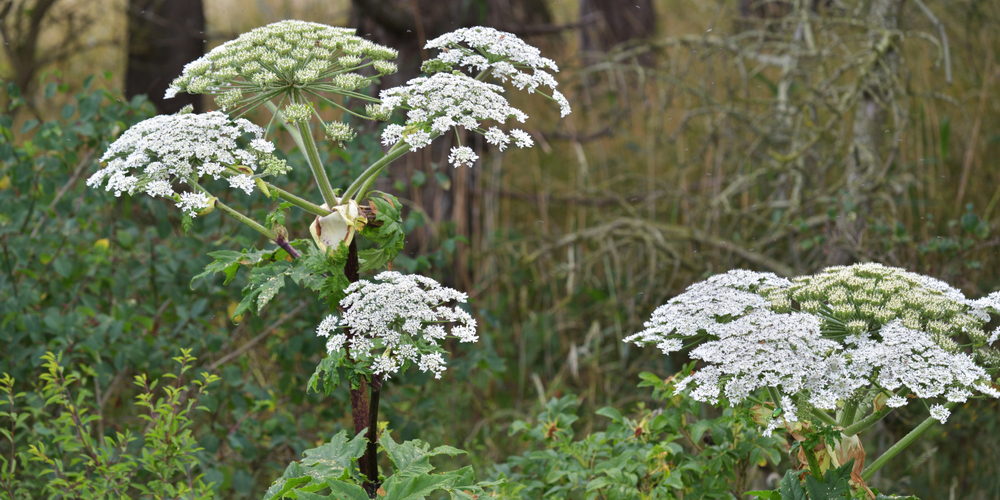Giant hogweed and poison hemlock plants look and behave almost identically, and many people confuse them because of their similarities. How can you tell which plant is growing in your yard? Let’s compare Hogweed vs Hemlock.
Keep reading to learn to identify the differences between these two dangerous species.
What Is Hogweed?
Giant hogweed is related to the carrot family. This invasive plant soars high, reaching up to 14 feet tall, with ridges covering its hollow stems. A unique pattern marks these stems with red and purple splatters.
On top of hogweed stems grow groups of little white flowers. These flower clusters amass to over 2 feet in diameter. Beneath these flowers, hogweed plants have groups of compound leaves growing from individual branches.
Some people find hogweed challenging to identify because it looks similar to other plants like hemlock, Queen Anne’s lace, and cow parsnip.
Where Does Hogweed Grow?
Today, hogweed is an invasive plant in many countries, including the United States. However, it is native to Asian territory surrounding the Black and Caspian Seas.
In the United States, people report hogweed sightings most frequently in northern regions, specifically surrounding the Great Lakes. Giant hogweed invades many states, including these and more:
- Washington
- Vermont
- Pennsylvania
- Maine
- Maryland
- Ohio
Throughout these states, hogweed sprouts in spots with moist soil and lots of sunlight. Hogweed typically grows in these areas:
- Along roadsides
- Near rivers and streams
- Fields
- Forested areas
- Backyards
Is Hogweed Dangerous?
Giant hogweed is dangerous to humans. It produces poisonous sap with harmful side effects. However, you can easily avoid hogweed because of its size.
Contact with giant hogweed sap increases skin sensitivity to sunlight. In extreme cases, hogweed sap causes deep burns and blindness.
Reactions occur within four to five days of contact with giant hogweed. Symptoms can include:
- Rashes
- Burns
- Blisters
- Increased sun sensitivity
If you come into contact with hogweed, expect a reaction. There are ways to deter the severity. Wash your skin with soap and water immediately to rid any sap or irritants. Covering your skin and avoiding sunlight could help reduce your reaction, too.
What Is Hemlock?

Poison hemlock is a plant that looks similar to giant hogweed, wild carrots, Queen Annes’ lace, and wild parsnips.
Hemlock grows quite tall, sometimes reaching over ten feet tall. Hemlock has a distinct odor, often described as musty. It also has long green stems speckled with red and purple patches of color.
Hemlock produces leaves that many people describe as fern-like in appearance. Its white flowers bloom in clusters, forming an umbrella shape covering the stalk.
Where Does Hemlock Grow?
Poison hemlock is native to many places, including Europe, Western Asia, and North America.
In the United States, people popularized hemlock in the 1800s, believing it was a beautiful garden and landscaping plant. Many referred to it as a winter fern due it its leaves. Today, hemlock grows in almost every state in the United States.
Hemlock grows quickly and heartily, taking over affected sites. Hemlock commonly grows in shaded areas with damp soil. People also spot the plant along roads and in forests, fields, ditches, and marshes.
Is Hemlock Dangerous?
Hemlock is poisonous to humans. Each part of the plant (stem, flowers, leaves, and fruit) poses a threat. Even after the plant dies, its remains are toxic for several years.
Touching or eating this plant has potentially deadly side effects. Poison levels vary from plant to plant. Typically, hemlock in sunny areas is more dangerous. Symptoms appear quickly and include these and more:
- Dizziness
- Dilated pupils
- Trembling
- Slowed heartbeat
- Muscle paralysis
- Respiratory failure
If you come in contact with poison hemlock, seek treatment immediately by calling poison control to avoid severe reactions. Minimize your exposure risk by wearing long gloves, pants, and sleeved shirts.
Hogweed vs Hemlock: How to Tell
Both hogweed and poison hemlock look like Queens Anne’s Lace are dangerous and similar in appearance. Here is how to tell the two plants apart.
If you come across a tall flowering plant, it is likely hemlock rather than giant hogweed. Hemlock is much more common across the United States, while giant hogweed only grows in certain regions.
If you are still unsure, look carefully at the leaves. Giant hogweed grows large compound leaves, while poison hemlock has fern-like foliage. Leaf observation is the most reliable way to distinguish between Hogweed vs Hemlock.

